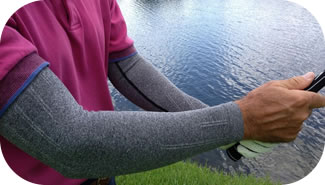Compression
 Basically, the idea of compression is to compact the torn muscle so that the area has an opportunity to heal faster. The heart pumps blood that contains oxygen to our limbs and other places in the body. Our cells use the oxygen and other nutrients from our blood. When our oxygenated blood continues to flow properly, it not only aids in healing a muscle strain but also helps inflammation process correctly. When we run, our muscles “vibrate.” This vibration adds up over time and leads to fatigue in the muscle itself. This is why you see some runners wearing “compression” socks or sleeves. These socks or sleeves provide “graduated compression.” Which basically means, with all the movement (running, walking, swimming, lifting) that we do on a daily basis, the “shock” or vibration on our muscles can be supported and have less risk of developing a strain or pulled muscle: “Recent studies show that with an optimal level of consistent compression, the walls of the arteries will dilate, increasing the blood flow through them. Arterial blood flow has been shown to increase up to 40% during activity and 30% during recovery. This means that oxygen and nutrients will be able to flow more freely throughout the body” (1). Compression stabilizes the muscle and decreases vibration in the muscle. This helps decrease fatigue, increase blood flow, prevent muscle strain from occurring, and help heal muscle strain once it has occurred.
Basically, the idea of compression is to compact the torn muscle so that the area has an opportunity to heal faster. The heart pumps blood that contains oxygen to our limbs and other places in the body. Our cells use the oxygen and other nutrients from our blood. When our oxygenated blood continues to flow properly, it not only aids in healing a muscle strain but also helps inflammation process correctly. When we run, our muscles “vibrate.” This vibration adds up over time and leads to fatigue in the muscle itself. This is why you see some runners wearing “compression” socks or sleeves. These socks or sleeves provide “graduated compression.” Which basically means, with all the movement (running, walking, swimming, lifting) that we do on a daily basis, the “shock” or vibration on our muscles can be supported and have less risk of developing a strain or pulled muscle: “Recent studies show that with an optimal level of consistent compression, the walls of the arteries will dilate, increasing the blood flow through them. Arterial blood flow has been shown to increase up to 40% during activity and 30% during recovery. This means that oxygen and nutrients will be able to flow more freely throughout the body” (1). Compression stabilizes the muscle and decreases vibration in the muscle. This helps decrease fatigue, increase blood flow, prevent muscle strain from occurring, and help heal muscle strain once it has occurred.

